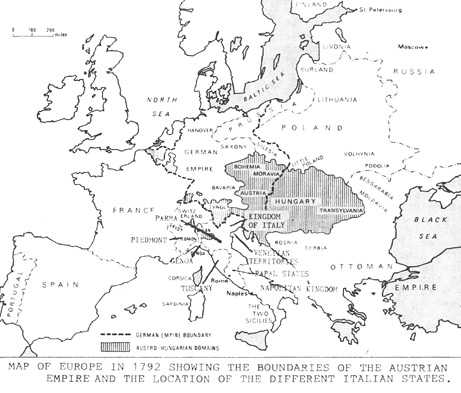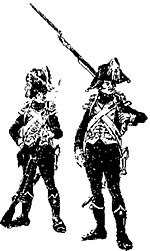
Many questions on Italian troops in French service have been received. It is a complex subject which has to be covered carefully. The first fact is that Italy, as we know it today, did not exist yet. It was broken down in several states, one of which, Lonbardy, was in 1792, part of the Austrian Empire. So, in order to understand the reasons behind the existence of Italian units it is imperative to take a quick look at the historical events that tool< place between 1792 and 1809 and reshaped, to a certail extent, the map of Italy. The map -- that of Europe in 1792 -- shows the boundaries of the Austrian Empire and of the different countries of Northern Italy. Each one of them is examined below:
(1) The Treaty of Campo-Formio (17 October 1797) ceded Belgium (i.e. the Austrian Netherland) to France and Lonbardy became theoretically independent under the name of Cisalpine Republic. (In 1802 it was organized, on the French model, in 12 departments.) It became the Italian Republic :1n 1802 and the Kingdom of Italy in ?804. The new kingdom was enlarged by the the Venetian territory given up by Austria by the Treaty of Pressburg (26 December 1805), following the cataclysm of Austerlitz. Technically speaking, the Kingdom of Italy (Napoleon was King of Italy) was independent and never became part of France. The troops raised in that Kingdom never became part of the French Army and should be considered as Allied troops.
(2) In 1797, all rights on Piedmont were ceded to France by CharlesAlbert, King of Sardinia, when that King withdrew to Sardinia. Consequently Piedmont became the 27th division militaire and part of France by a Senatus-Consulte of 11 September 1802. The troops of the King of Sardinia were incorporated in the French army in 1799 and all the troops raised after 1802 in Piedmont are classified as French troops.
(3) In 1797, the territory of Genoa became the Ligurian Republic and in 1805 requested to become part of France. It became the 28th division militaire, so after 1805, the Ligurian troops became French troops. These troops do not belong to the French army prior to 1805.
(4) In 1802, after the death of King Ferdinand, the States of Parma and Plaisance were administrated by "Moreau-Saint-Mery and annexed to France by a Senatus-Consulte of 24 May 1808 and became the department of Taro. Hence, the troops of Parma were incorporated in the French army in 1808.
(5) After the death of King Louis the IInd, in 1807, the Kingdom of Estruria (i.e. Tuscany) passed under the control of Queen Maria-Luisa until the Treaty of Fontainebleau (27 October 1807) annexed Tuscany to France. It became the 29th division militaire and the Tuscan troops became part of the French army in 1807.
(6) In 1797, Rome became the Roman Republic but disappeared in 1801 when part of its territory was returned to the Pope and the rest became part of the Cisalpine Republic. A decree of 18 May 1809 annexed the Papal States to France and consequently, after 1809, the troops raised in that territory are considered French.
We hope the above will help somewhat the readers to understand what took place in Northern Italy between 1792 and 1814.
 Tirailleurs du Po
Tirailleurs du Po
Now, let us take a look at a very interesting unit: the Tirailleurs du Po on which very little information has been published. Yet, that famous formation is found in some of the Napoleonic period's greatest battles: Austerlitz, Ebelsberg, Wagram etc. We always find the unit brigaded with the Tirailleurs Corses on which much more is known. We covered them in a past issue of EEL.
Carabiniers: 1803 (left) and 1805 (right)
Like the Legion du Midi (or Legion Piemontaise to be covered in our next issue) the Tirailleurs du Po were raised from volunteers of the 27e division militaire, i.e. the Piedmont, and were considered to be a French unit. The battalion was organized in 1803 in the French city of Sete under the name of 'Bataillon Expeditionnaire Piemontais' and became in December 1803 'Bataillon de Tirailleurs du Po'.
The Tirailleurs du Po received a flag in 1803 and an Eagle in 1804 like the other infantry units of the French army.
In December 1805, we find the 'Tirailleurs du Po' at Austerlitz as part of Davout's command. They fought very well around Sokolnitz.
At the beginning of the Campaign of 1809, the Tirailleurs du Po had an effective strength of some 1118 officers and men. They were engaged at Ebelsberg and suffeered heavy losses.
The battalion was organized as a light battalion and included 9 companies, 1 of voltigeurs, 1 of carabiniers and 7 of chasseurs. Like the Tirailleurs Corses, the Tirailleurs du Po were not affected bythe reorganization of 1803, which changed the French infantry from a 9 company battalion to a 6 company battalion. Thus, during the Campaign of 1809, the Tirailleurs du Po, now part of Oudinot's Grenadiers (Claparede's Division), kept their organization of 9 companies
Their basic uniform was that of the light infantry, i.e. blue, but the similarity appears to end there. Facings, turnbacks and cuffs were red. The collar was blue including the carabiniers and voltigeurs. The carabiniers had red epaulettes (see picture below). My data does not cover the voltigeur uniform so we can not positively say that the voltigeurs had green (or yellow) epaulettes. The same applies to the chas-seurs. The carabiniers received the bearskin in 1804 and the voltigeurs and chasseurs may have received the shako at the same period. However, that is far to be sure since our source, Commandant Bucquoy's Gardes d'Honneur et Troupes Etrangeres, reports that only a painting by Horace Vernet show a voltigeur of the Tirailleures de Po wearing a shako.
All the other sources - Marbot, Vernier, Valmont etc, show the voltigeurs, etc. with the older bicorn hat. The plumes are red for the carabiniers and the musicians, but unknown for the voltigeurs and chasseurs. (We'll be glad to complete the limited information presented above and to correct where I might be wrong.) Furthermore, the buttons were brass instead of the traditional white buttons of the light infantry. The Tirailleurs du Po were disbanded in 1811 and incorporated in the reformed 11th Regiment d'Infanterie Legere.
Additional Sources:
General Jean Regnault Les Aigles Imperiales 1804-15, Paris.
Belhomme: Histoire de l'Infanterie en France.
Back to Empire, Eagles, & Lions Table of Contents Vol. 1 No. 84
Back to EEL List of Issues
Back to MagWeb Master Magazine List
© Copyright 1985 by Emperor's Headquarters
This article appears in MagWeb.com (Magazine Web) on the Internet World Wide Web.
Other articles from military history and related magazines are available at http://www.magweb.com
